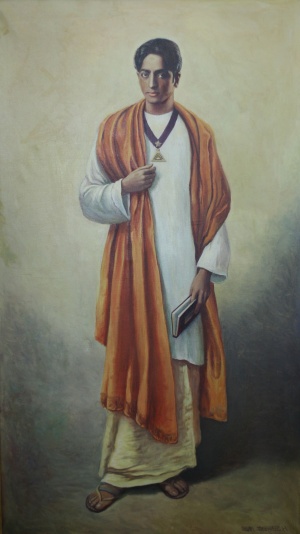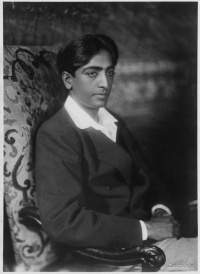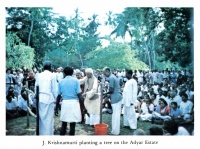Jiddu Krishnamurti: Difference between revisions
Pablo Sender (talk | contribs) No edit summary |
Pablo Sender (talk | contribs) No edit summary |
||
| Line 5: | Line 5: | ||
[[File:Krishnamurti painting.jpg|300px|right|thumb|J. Krishnamurti portrait in L. W. Rogers Building. Painted from a photograph in 1926 by Henry Schwartz. Image from TSA Archives.]] | [[File:Krishnamurti painting.jpg|300px|right|thumb|J. Krishnamurti portrait in L. W. Rogers Building. Painted from a photograph in 1926 by Henry Schwartz. Image from TSA Archives.]] | ||
'''Jiddu Krishnamurti''' ([[May | '''Jiddu Krishnamurti''' ([[May 11]], 1895 – [[February 17]], 1986) was an author and lecturer on spiritual and philosophical subjects who had a major impact on Twentieth Century thought. He was "discovered" as a child in India by [[Charles Webster Leadbeater|Charles W. Leadbeater]], who believed that the boy had the potential to become a great religious leader. Krishnamurti and his brother Nitya were educated by Theosophists at the [[Theosophical Society (Adyar)|Theosophical Society]] based in Adyar, Chennai,India. Adyar Theosophists established the [[Order of the Star in the East]] to promote the idea the Krishnamurti was the much-anticipated "World Leader" or Maitreya. Eventually Krishnamurti rejected the role and the organization, and taught that "Truth is a pathless land". | ||
Krishnamurti was often referred to by his friends as "K". | Krishnamurti was often referred to by his friends as "K". | ||
| Line 23: | Line 23: | ||
<blockquote>It could not have been Krishna's outward appearance that struck Leadbeater, for apart from his wonderful eyes, he was not at all prepossessing at that time. He was under-nourished, scrawny and dirty; his ribs showed through his skin and he had a persistent cough; his teeth were crooked and he wore his hair in the customary Brahmin fashion of South India, shaved in front to the crown and falling to below his knees in a pigtail at the back; moreover his vacant expression gave him an almost moronic look.<ref>Mary Lutyens, ''Krishnamurti: The Years of Awakening'' (New York: Farrar, Straus and Giroux, 1975), 21.</ref></blockquote> | <blockquote>It could not have been Krishna's outward appearance that struck Leadbeater, for apart from his wonderful eyes, he was not at all prepossessing at that time. He was under-nourished, scrawny and dirty; his ribs showed through his skin and he had a persistent cough; his teeth were crooked and he wore his hair in the customary Brahmin fashion of South India, shaved in front to the crown and falling to below his knees in a pigtail at the back; moreover his vacant expression gave him an almost moronic look.<ref>Mary Lutyens, ''Krishnamurti: The Years of Awakening'' (New York: Farrar, Straus and Giroux, 1975), 21.</ref></blockquote> | ||
Soon, C. W. Leadbeater started researching their [[Reincarnation|past lives]] and become aware of their relationship with himself and the [[Masters of Wisdom|Masters]]. These accounts were published in articles in [[The Theosophist (periodical)|''The Theosophist'']], the mystic name given to Krishnamurti being Alcyone. All these accounts were eventually published in the book [[Lives of Alcyone (book)|''Lives of Alcyone'']]. | Soon, C. W. Leadbeater started researching their [[Reincarnation|past lives]] and become aware of their relationship with himself and the [[Masters of Wisdom|Masters]]. These accounts were published in articles in [[The Theosophist (periodical)|''The Theosophist'']], the mystic name given to Krishnamurti being [[Alcyone]]. All these accounts were eventually published in the book [[Lives of Alcyone (book)|''Lives of Alcyone'']]. | ||
During this time a group of [[Theosophist]]s began to take care of him and his younger brother, Nityananda. They nourished them physically, and taught them hygiene, yogic postures, breathing exercises, and sports. Eventually they also took care of their academic education. | During this time a group of [[Theosophist]]s began to take care of him and his younger brother, Nityananda. They nourished them physically, and taught them hygiene, yogic postures, breathing exercises, and sports. Eventually they also took care of their academic education. | ||
[[Annie Besant]], who was abroad on a tour, met them for the first time on [[November 27]], 1909. On [[March 6]], 1910 she became their legal guardian. | |||
== Discipleship and Initiation == | == Discipleship and Initiation == | ||
[[Charles Webster Leadbeater|C. W. Leadbeater]] reported that on the night of [[August 1]], 1909, [[Koot Hoomi|Master K.H.]] had put Krishnamurti on [[probation]]. | |||
Then, Leadbeater started taken him every night in his [[Astral Body|astral body]] to the house of the Master to be instructed for fifteen minutes. The next morning Krishnamurti would write down what he remembered, and these notes were later published as the book [[At the Feet of the Master (book)|''At the Feet of the Master'']]. | |||
After only five months of probation he was accepted as a [[chela]], and received his [[Initiation#First Initiation|first initiation]] on [[January 11]], 1910. | |||
== World Teacher movement == | == World Teacher movement == | ||
Revision as of 21:46, 12 May 2014

ARTICLE UNDER CONSTRUCTION
ARTICLE UNDER CONSTRUCTION
Jiddu Krishnamurti (May 11, 1895 – February 17, 1986) was an author and lecturer on spiritual and philosophical subjects who had a major impact on Twentieth Century thought. He was "discovered" as a child in India by Charles W. Leadbeater, who believed that the boy had the potential to become a great religious leader. Krishnamurti and his brother Nitya were educated by Theosophists at the Theosophical Society based in Adyar, Chennai,India. Adyar Theosophists established the Order of the Star in the East to promote the idea the Krishnamurti was the much-anticipated "World Leader" or Maitreya. Eventually Krishnamurti rejected the role and the organization, and taught that "Truth is a pathless land".
Krishnamurti was often referred to by his friends as "K".
Early years
Jiddu Krishnamurti was born was born a Brahmin on May 11 1895 in Madanapalle, Andhra Pradesh, near Madras in the south of India. He was the eight son and, in keeping with tradition, was named after Sri Krishna.
Although his father, Jiddu Narianiah, was educated at Madras University and worked for the British Administration, the standard of life of the family was not good. Only five or six of the eleven children of the family would survive childhood. When Krishnamurti was two years old he nearly died of malaria, and his mother, Jiddu Sanjeevamma, eventually died of it when he was only ten.
In 1907 his father was given a compulsory retirement. Having been a member of the Theosophical Society since 1882,[1] he eventually obtained a job at its International Headquarters in Adyar, Madras (now Channai).
"Discovery"
On January 23, 1909, the Jiddu family moved to Madras. In May of that year, Theosophical leader and clairvoyant C. W. Leadbeater runs into 13-year old Krishnamurti who was playing in the beach, and sees "the most wonderful aura he has ever seen, without a particle of selfishness". Although Theosophist and scholar Ernest Wood, who had tried to help him with his homework, considered him dim-witted, Leadbeater predicted that he would become a spiritual teacher and a great orator "much greater" than even Annie Besant. His Biographer Mary Luthyens wrote:
It could not have been Krishna's outward appearance that struck Leadbeater, for apart from his wonderful eyes, he was not at all prepossessing at that time. He was under-nourished, scrawny and dirty; his ribs showed through his skin and he had a persistent cough; his teeth were crooked and he wore his hair in the customary Brahmin fashion of South India, shaved in front to the crown and falling to below his knees in a pigtail at the back; moreover his vacant expression gave him an almost moronic look.[2]
Soon, C. W. Leadbeater started researching their past lives and become aware of their relationship with himself and the Masters. These accounts were published in articles in The Theosophist, the mystic name given to Krishnamurti being Alcyone. All these accounts were eventually published in the book Lives of Alcyone.
During this time a group of Theosophists began to take care of him and his younger brother, Nityananda. They nourished them physically, and taught them hygiene, yogic postures, breathing exercises, and sports. Eventually they also took care of their academic education.
Annie Besant, who was abroad on a tour, met them for the first time on November 27, 1909. On March 6, 1910 she became their legal guardian.
Discipleship and Initiation
C. W. Leadbeater reported that on the night of August 1, 1909, Master K.H. had put Krishnamurti on probation.
Then, Leadbeater started taken him every night in his astral body to the house of the Master to be instructed for fifteen minutes. The next morning Krishnamurti would write down what he remembered, and these notes were later published as the book At the Feet of the Master.
After only five months of probation he was accepted as a chela, and received his first initiation on January 11, 1910.
World Teacher movement
Life-altering experiences
Death of his brother
Rejection of World Teacher role
Speaking tours
Krishnamurti schools
Later years
Teachings
Writings
Online resources
Audio
- Krishnamurti and Eastern Philosophy by Ravi Ravindra
- Krishnamurti on the Masters by Aryel Sanat


